Five Major Water-Quality Characteristics Were Evaluated for Ground-Water Studies in Each NAWQA Study Unit
 |
Ground-water resources were divided into two categories: (1) drinking-water aquifers, and (2) shallow ground water underlying agricultural or urban areas. Summary scores were computed for each characteristic for all aquifers and shallow ground-water areas that had adequate data. Scores for each aquifer and shallow ground-water area in the Nevada Basin and Range Study Unit were compared with scores for all aquifers and shallow ground-water areas sampled in the 20 NAWQA Study Units during 1992-95. Results are summarized by percentiles; higher percentile values generally indicate poorer quality compared with other NAWQA ground-water studies. Water-quality conditions for each drinking-water aquifer also are compared to established drinking water standards and criteria for protection of human health. (Methods used to compute rankings and evaluate standards and criteria are described by Gilliom and others [58].) |
| Dissolved Solids in Las Vegas Valley Water-Supply Wells Were Greater
Than the National 75th Percentile
Dissolved-solids concentrations in deeper supply wells and shallow monitoring wells in Las Vegas Valley and shallow monitoring wells in Carson Desert and Reno-Sparks area were greater than the 75th percentile of NAWQA sites nationwide. Dissolved-solids concentrations in supply wells in Carson Valley and the Reno-Sparks area were less than the national median. The SMCL (500 mg/L) was exceeded in some samples from all areas except Carson Valley supply wells. Shallow monitoring wells in basin areas (Las Vegas Valley and Carson Desert) had the highest frequency of exceedence (97 and 70 percent, respectively); these high concentrations were caused by dissolution of evaporite minerals (salts) and their concentration in ground water by evapotranspiration. |
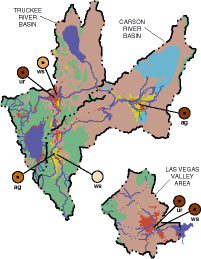 |
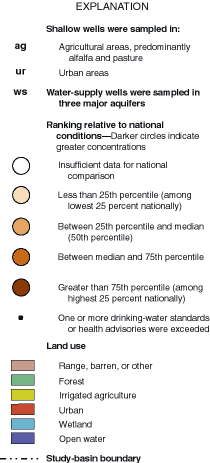 |
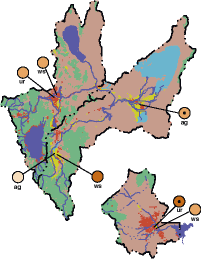 |
Nitrate in Samples From Water-Supply Wells Approached the National
Median
Nitrate concentrations in Study Unit water-supply wells were close to the national median for NAWQA drinking-water supply wells. Shallow monitoring wells in agricultural areas (Carson Valley and Carson Desert) had nitrate concentrations less than the national median, and those in urban areas (Las Vegas and Reno-Sparks) had concentrations near or greater than the national median. In the NVBR Study Unit, high nitrate concentrations were uncommon and possibly were due to fertilizer application, septic systems, or leaking sewer pipes in urbanized areas. Concentrations of nitrate did not exceed the MCL for any NAWQA samples collected from water-supply wells in the Study Unit. |
| Pesticides in the Reno-Sparks Urban Area Were Detected More Frequently
Than the National Median
The frequencies of pesticide detections in samples from water-supply and shallow monitoring wells in the Reno-Sparks urban area were between the national NAWQA median and the 75th percentile. Pesticides used on urban landscapes are leached into ground water by irrigation. In all areas sampled, except the Reno-Sparks urban area, pesticides were detected in ground-water samples less frequently than the national median. |
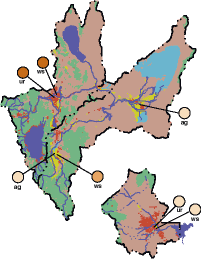 |
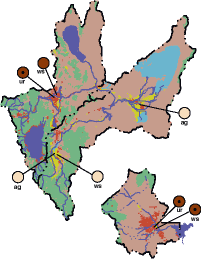 |
Volatile Organic Compounds (VOCs) in the Las Vegas and Reno-Sparks
Urban Areas Were Detected More Frequently Than the National 75th Percentile
The frequencies of detection for VOCs in the urban areas of Las Vegas and Reno-Sparks (both water-supply wells and shallow monitoring wells) were greater than the 75th percentile of NAWQA wells nationwide. Trihalomethanes (THMs), chlorinated solvents, and a gasoline oxygenate (MTBE) were the most frequently detected VOCs. Concentrations of several VOCs in water from supply wells in the Las Vegas urban area and from shallow monitoring wells in Las Vegas and Reno-Sparks urban areas exceeded MCLs (the chlorinated solvents--tetrachloroethylene and trichloroethylene) or a drinking water advisory (MTBE). Water-supply wells and shallow wells in agricultural areas had less frequent detections of VOCs than the 25th percentile of NAWQA wells nationwide. |
| Radon in Carson Valley and Reno-Sparks Urban Area Water-Supply Wells
was Greater Than the National 75th Percentile
Radon, a decay product of uranium in granitic rocks in the Study Unit,
occurs naturally in soils. Radon concentrations in water from supply and
shallow monitoring wells in the Las Vegas urban area were less than the
national median. Concentrations in water from supply wells in Carson Valley
and the Reno-Sparks area and shallow monitoring wells in Carson Valley
exceeded the 75th percentile of NAWQA sites nationwide. Shallow monitoring
wells in the Reno-Sparks area had radon concentrations greater than the
national median. Carson Valley and Reno-Sparks area soils were derived,
in part, from granitic rocks in the Sierra Nevada.
|
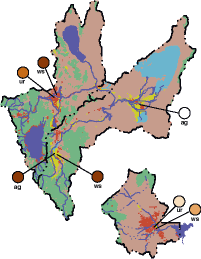 |
| CONCLUSIONS |
Compared to other NAWQA Study Units:
|
 |
A shallow monitoring well being installed in the Las Vegas urban area,
August 1993. Photograph by Kenneth J. Covay, U.S. Geological Survey.
|